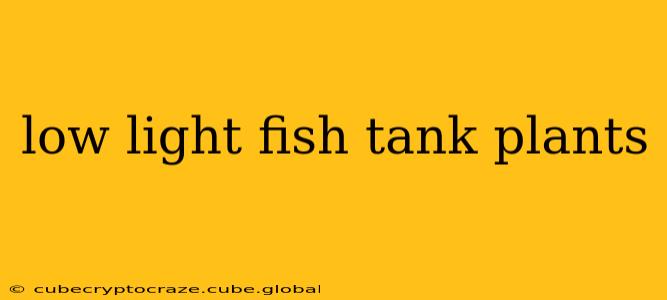Choosing the right plants for your fish tank can be tricky, especially if your tank doesn't get a lot of natural light. Many aquatic plants require bright, intense lighting to thrive, but there are plenty of beautiful and hardy options that will flourish even in low-light conditions. This guide will help you select the perfect low-light fish tank plants to create a lush and healthy underwater landscape.
What are Low-Light Plants?
Low-light aquarium plants are species adapted to survive and grow with less intense and shorter durations of light than their high-light counterparts. They are typically slower-growing, but their resilience makes them ideal for beginners and those with limited lighting options. These plants are less demanding in terms of their needs, making them a great choice for those new to aquascaping or those who prefer a lower-maintenance setup.
Best Low-Light Aquarium Plants: A Diverse Selection
Several excellent low-light plants offer diverse textures, colors, and growth habits, allowing you to create a visually appealing aquascape. Here are some top choices:
Java Fern (Microsorum pteropus):
A classic and incredibly popular choice, Java Fern is known for its hardiness and adaptability. It requires minimal care, tolerates a wide range of water parameters, and readily attaches to hardscape like rocks or driftwood, making it a versatile option for various tank setups.
Anubias Nana:
Another incredibly low-maintenance plant, Anubias nana is a slow-growing rhizome plant that thrives in low-light conditions. Its small size and ability to attach to decor make it perfect for smaller tanks or as a focal point in larger aquascapes. Avoid burying the rhizome in substrate as this can cause rot.
Amazon Sword (Echinodorus amazonicus):
While it prefers moderate light, the Amazon Sword can tolerate low light conditions, although growth will be slower. This impressive plant adds a stately presence to the tank and offers a great hiding place for smaller fish.
Cryptocoryne species (e.g., Cryptocoryne wendtii):
Cryptocorynes are known for their resilience and ability to adapt to varying water parameters. They come in various sizes and colors, providing flexibility in designing your aquascape. They are slower growing but very rewarding in low-light environments.
Java Moss (Taxiphyllum barbieri):
A beautiful and easy-to-care-for moss, Java Moss is perfect for covering rocks, driftwood, or even creating a lush carpet on the substrate. Its delicate texture adds a unique element to the tank and provides excellent hiding places for fry (baby fish).
How Much Light Do Low-Light Plants Need?
While labeled "low-light," these plants still require some light to photosynthesize. Aim for 6-8 hours of indirect light per day. A low-wattage aquarium light (around 1-2 watts per gallon) or strategically placed LED lights can provide sufficient illumination. Avoid placing your tank in direct sunlight, as this can lead to algae blooms and harm your plants.
What are the best artificial lights for low light plants?
LED aquarium lights are generally the best choice for low-light setups. They are energy-efficient, produce minimal heat, and offer customizable lighting options, allowing you to fine-tune the light intensity and spectrum to suit your plants' needs. Look for LED lights with a spectrum that includes reds and blues, as these are crucial for plant growth.
How often should I fertilize low light plants?
Low-light plants generally require less fertilization than their high-light counterparts. However, regular fertilization with a liquid aquarium fertilizer specifically formulated for planted tanks can still help promote healthy growth. Start with a diluted solution and gradually increase the dosage as needed. Observe your plants closely for any signs of deficiency (e.g., yellowing leaves) and adjust accordingly.
What if my low-light plants are not growing?
Several factors can affect the growth of low-light plants, including insufficient light, nutrient deficiencies, poor water quality, or overcrowding. Ensure your tank is receiving adequate light, test your water parameters regularly, and consider thinning out your plants if they become too crowded. If you suspect a nutrient deficiency, supplement with a liquid fertilizer specifically formulated for planted tanks.
By choosing the right plants and providing adequate care, you can create a stunning and thriving low-light aquarium. Remember that patience is key – slow growth is typical for these species, so don't get discouraged if you don't see immediate results. Enjoy the process of watching your aquascape develop over time!
